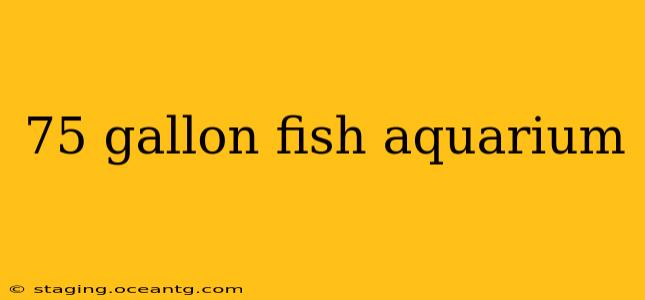A 75-gallon fish aquarium represents a significant step up from smaller tanks, offering ample space for a diverse and thriving aquatic ecosystem. Whether you're a seasoned aquarist or just starting your journey, this comprehensive guide will equip you with the knowledge and insights to successfully set up and maintain a 75-gallon aquarium. We'll cover everything from choosing the right tank and equipment to selecting compatible fish and plants, ensuring your aquatic paradise flourishes.
What Size Stand Do I Need for a 75 Gallon Aquarium?
Choosing the right stand is crucial for the structural integrity and longevity of your 75-gallon aquarium. A filled 75-gallon tank weighs over 600 pounds, so a sturdy, specifically designed aquarium stand is essential. Never use a repurposed piece of furniture. Look for a stand explicitly rated for at least 75 gallons or more, ideally with reinforced framing and a weight capacity significantly exceeding the tank's full weight. Consider the dimensions of your chosen tank and ensure the stand accommodates it comfortably, leaving sufficient space around the base for access and maintenance.
How Much Does a 75 Gallon Fish Tank Cost?
The cost of a 75-gallon fish tank can vary considerably depending on several factors. The tank itself can range from a few hundred to over a thousand dollars, depending on the manufacturer, materials (glass or acrylic), and any added features. You'll also need to budget for the stand, filter, heater, lighting, substrate, decorations, water testing kit, and of course, the fish and plants themselves. It's prudent to create a detailed budget before making any purchases to avoid unexpected expenses. A realistic total cost could range from $500 to $1500 or more, depending on your choices.
What Fish Can Go in a 75 Gallon Tank?
A 75-gallon tank opens up a world of possibilities for fishkeeping. You can house a variety of larger fish species, shoals of smaller schooling fish, or a combination of both. However, careful research into species compatibility is paramount. Consider factors like adult size, temperament, and water parameter requirements. For example, you could keep several larger cichlids, a group of larger tetras, or even a combination of different peaceful community fish. Always research the specific needs of each species you intend to add before introducing them to the tank to prevent conflict and ensure their well-being.
How Many Fish Can I Put in a 75 Gallon Tank?
The number of fish you can safely keep in a 75-gallon tank depends heavily on the size of the fish and their specific needs. A general rule of thumb is the "one-inch-per-gallon" rule, but this is just a guideline and should be adjusted based on the species. Larger fish require considerably more space. It’s crucial to research the adult size of each fish you intend to keep and prioritize their individual space requirements over simply adhering to a numerical limit. Overstocking can lead to poor water quality and stress on the fish, potentially causing illness or death.
How Often Should I Change the Water in a 75 Gallon Tank?
Water changes are a critical part of maintaining a healthy 75-gallon aquarium. While the exact frequency varies depending on the stocking level and filtration system, a general recommendation is to perform partial water changes (25-50%) weekly or bi-weekly. This helps remove waste products and maintain stable water parameters. Always use a dechlorinator to remove chlorine and chloramine from tap water before adding it to the tank. Regular water changes are essential for preventing ammonia, nitrite, and nitrate buildup, which can be fatal to fish.
What Kind of Filter Do I Need for a 75 Gallon Aquarium?
A powerful and reliable filtration system is crucial for a 75-gallon tank. Consider a canister filter or a large sump filter, both capable of handling the volume of water and efficiently removing waste. The filter's capacity should be significantly higher than the tank's volume to ensure effective biological filtration. The chosen filter should also have sufficient media space for biological filtration materials (like ceramic rings or filter sponges) which house the beneficial bacteria essential for breaking down harmful waste products.
In conclusion, maintaining a 75-gallon fish aquarium is a rewarding experience, but it requires commitment and planning. By carefully considering the factors outlined above and conducting thorough research, you can create a thriving aquatic ecosystem that brings years of enjoyment. Remember, responsible fishkeeping is key to the health and well-being of your aquatic companions.
